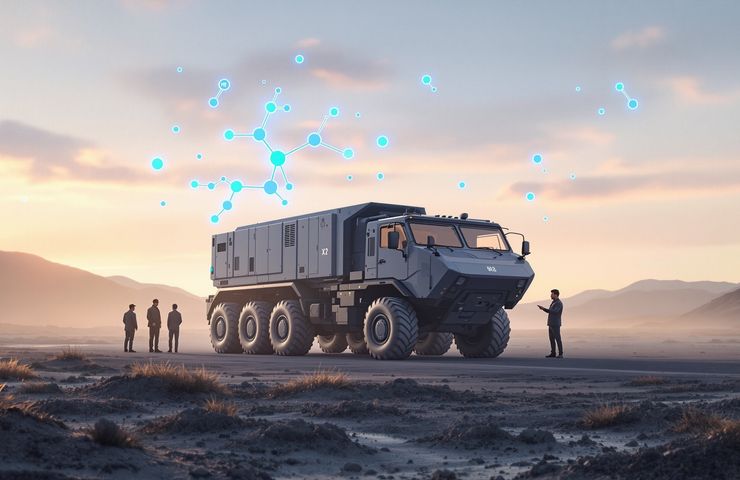
Hydrogen Fuel Cells Power Hyundai Rotem’s New 8×8 Hybrid Armored Vehicle Prototype
October 24, 2025Imagine an armored vehicle that hums along like a whisper, pumps out zero emissions, and slips across rough terrain without announcing itself. On October 24, 2025, Hyundai Rotem unveiled exactly that: an 8×8 hybrid armored vehicle running on hydrogen fuel cells and electric propulsion. Putting this prototype through its paces at Changwon-si, the company is challenging armies to rethink mobility, protection, and environmental impact all in one go.
Changwon-si has been South Korea’s heavy-industry hub since the 1970s—diesel tanks and railcars have rolled off these lines for ages. Now, engineers here are swapping out old-school engines for a cleaner powertrain. Every lap at the proving grounds underlines Hyundai Rotem’s push toward zero-emission technology in defense, fusing decades of battlefield expertise with bold innovation.
At a glance, it’s a familiar eight-wheeler, but under the skin it’s a whole new animal. Instead of diesel, a combo of hydrogen fuel cells and lithium-ion batteries takes the reins. Despite packing the same heft as conventional APCs and IFVs, this hybrid delivers instant torque, near-silent operation, and a cool exhaust plume—perfect for staying off the radar.
Under the Hood: Hydrogen Fuel Cell Power
Pressurized hydrogen sits in reinforced tanks, ready to power a polymer electrolyte membrane fuel cell technology setup. Inside each cell, hydrogen meets oxygen, producing electricity (and a bit of heat) while releasing only water vapor. No soot, no growling engine. Hyundai Rotem’s team has fine-tuned the system to pump out several hundred kilowatts—enough muscle to rival or beat traditional diesel drivetrains.
Electric Propulsion in Combat
The juice from fuel cells and onboard batteries feeds a bank of wheel-mounted motors. Each motor can be dialed in separately for traction vectoring, delivering exceptional maneuverability over rocky or muddy terrain. Maintenance crews get a break, too—no oil swaps or intricate gearboxes means faster battlefield repairs and higher operational uptime.
Stealth and Survivability
This isn’t just about green credentials. Today’s sensors pick up the slightest noise or heat, and an electric powertrain cuts both signatures dramatically. The near-silent whirr and cool exhaust make it far harder to detect with acoustic or thermal cameras. In night ops or recon missions, that stealth edge can be a real lifesaver.
And this prototype isn’t a one-off showcase. It dovetails with South Korea’s national push for sustainable energy and homegrown defense innovation. By parading the 8×8 at ADEX and live trials, Hyundai Rotem is staking its claim at the forefront of a global shift toward clean-energy military vehicles. Nations eager to trim emissions without dulling combat effectiveness may find this hybrid platform impossible to ignore.
A Greener Trajectory
Seoul has earmarked hydrogen as key to its future power mix, pouring resources into hydrogen infrastructure and refueling networks. Military uptake could spark a wider rollout of hydrogen stations—fast-tracking civilian adoption, too. Cutting fossil fuel reliance dovetails with broader decarbonization goals, creating a rare win-win for defense and climate policy.
The tech could even jump off the battlefield into civilian life. Armored personnel carriers share a lot with commercial trucks and buses, so suppliers building high-pressure hydrogen tanks, fuel cells, and electric motors for the military might scale up for public transit or freight fleets. And lessons learned in rapid repairs under fire? They could make everyday vehicles tougher and more reliable.
Hyundai’s Cross-Sector Play
Backing this effort is the broader Hyundai Motor Group’s drive into hydrogen mobility. Innovations from rail and bus projects feed into the 8×8, and breakthroughs in defense flow back to civilian lines. It’s a two-way street that speeds up R&D and expands the supplier base. If the hybrid 8×8 proves its worth, expect modular hydrogen-electric drive units to pop up across both military and commercial platforms—driving costs down even further.
Of course, challenges remain: bringing down hydrogen production costs, sorting out battlefield refueling, and proving these systems can endure in combat. Yet by marrying robust electric drivetrains with advanced fuel cell technology, Hyundai Rotem offers a glimpse of next-gen warfare that’s quieter, cleaner, and potentially more resilient. That dusty test track in Changwon-si could be the proving ground for the future of armored combat.
About Hyundai Rotem
Founded in 1977, Hyundai Rotem is a South Korean powerhouse in railway vehicles, defense systems, and heavy machinery. As part of the Hyundai Motor Group, it’s long led the rail sector and ground weapon platforms—including the K2 main battle tank—and now it’s driving forward into hydrogen-fueled mobility.



 With over 15 years of reporting hydrogen news, we are your premier source for the latest updates and insights in hydrogen and renewable energy.
With over 15 years of reporting hydrogen news, we are your premier source for the latest updates and insights in hydrogen and renewable energy.